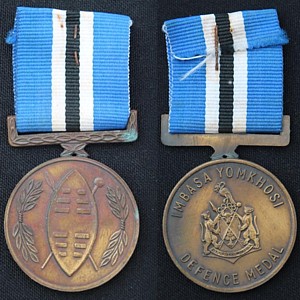This page is based on this
Wikipedia article Text is available under the
CC BY-SA 4.0 license; additional terms may apply.
Images, videos and audio are available under their respective licenses.

The Distinguished Service Cross (DSC) is a third level military decoration awarded to officers, and since 1993 ratings and other ranks, of the British Armed Forces, Royal Fleet Auxiliary and British Merchant Navy, and formerly also to officers of other Commonwealth countries.

The United States Armed Forces awards and decorations are primarily the medals, service ribbons, and specific badges which recognize military service and personal accomplishments while a member of the U.S. Armed Forces. Such awards are a means to outwardly display the highlights of a service member's career.

A service star is a miniature bronze or silver five-pointed star 3⁄16 inch in diameter that is authorized to be worn by members of the seven uniformed services of the United States on medals and ribbons to denote an additional award or service period. The service star may also be referred to as a campaign star or battle star depending on which award is authorized the star and the manner in which the device is used for the award.

Leif Andreas Larsen DSO, DSC, CGM, DSM and Bar, popularly known as "Shetlands Larsen", was a Norwegian sailor and the most highly decorated allied naval officer of World War II. He was arguably the most famous of the men who operated the Shetland bus escape route during the war.

The Philippine Liberation Medal is a military award of the Republic of the Philippines which was created by an order of Commonwealth Army of the Philippines Headquarters on 20 December 1944, and was issued as the Philippine Liberation Ribbon. The decoration was presented to any service member, of both Philippine Commonwealth and allied militaries, who participated in the liberation of the Philippine Islands between the dates of 17 October 1944, and 2 September 1945. A full-sized medal was authorized and added on 22 July 1945.

Home guard is a title given to various military organizations at various times, with the implication of an emergency or reserve force raised for local defense.
Authorized foreign decorations of the United States military are those military decorations which have been approved for wear by members of the United States armed forces but whose awarding authority is the government of a country other than the United States.

This is a list of Norwegian orders and medals, in order of precedence. This list contains all medals approved for wearing on a Norwegian military uniform in ranked order.

The Dekoratie voor Trouwe Dienst, post-nominal letters DTD, is a South African military decoration. It was instituted in 1920 as a retrospective award for Boer officers of the 1899–1902 Second Boer War.

The Korea Medal is a military campaign medal which was instituted by the Union of South Africa in 1953. It was awarded to volunteers of the Union Defence Forces for service in Korea during the 1950-1953 Korean War.

The General Service Medal is a military campaign medal which was instituted by the Republic of South Africa in 1987. It could be awarded to members of the South African Defence Force from 1 January 1983, for operational service inside South Africa in the prevention or suppression of terrorism or internal disorder, or the preservation of life, health or property, or the maintenance of essential services and law and order, or crime prevention.

The first South African military medal was a campaign medal, the South Africa Medal, instituted in 1854 by Queen Victoria, the Monarch of the United Kingdom of Great Britain and Ireland, for award to officers and men of the Royal Navy and British Army who served on the Eastern Frontier of the Cape Colony between 1834 and 1853 during the Xhosa Wars.

The Sandile Decoration, post-nominal letters SD, was instituted by the President of the Republic of Ciskei in 1988, for award to all ranks for meritorious service.

The Sandile Medal was instituted by the President of the Republic of Ciskei in 1988, for award to all ranks for meritorious service.

The Chief C.D.F. Commendation Medal was instituted by the President of the Republic of Ciskei in 1992, for award to all ranks for service commended by the Chief of the Ciskei Defence Force.

The Independence Medal was instituted by the President of the Republic of Ciskei in 1981, for award to all serving members of the Ciskei Defence Force on 4 December 1981 to commemorate the independence of Ciskei.

The Medal for Long Service, Bronze was instituted by the President of the Republic of Ciskei in 1988, for award to all ranks for ten years faithful service.

The President's Medal for Shooting was instituted by the President of the Republic of Ciskei in 1988, for award to champion shots.

















